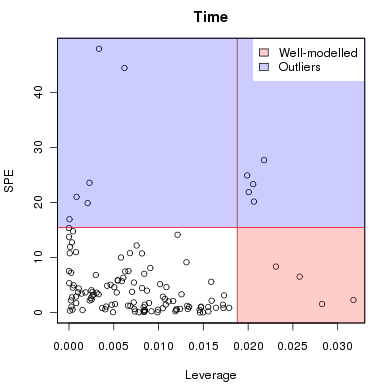ASCA identifies the major trends associated with each experimental factor and their interactions. The next step is to identify variables that are closely follow those detected trends as well as those that clearly diverge from the trends. The first ones would represent those variables that most co-coordinately respond in the experimental context; The second ones would be potential outliers. The variable selection strategy is based on the approach described by Nueda, M.J. et al.
An example figure is shown below. Important variables are put into two categories:
- ‘well-modeled’ refers to those that change co-coordinately to the major profile(s) depicted in the trajectory plots of the factor;
- ‘outliers’ refer to those with relevant changes but different from the major profile(s)
These variables are selected based on the Leverage (a measure of the importance of a variable’s contribution to the fitted ASCA-model - higher Leverage means more importance) and SPE (or squared prediction error, an evaluation of the goodness of fit of the model to a particular variable - higher SPE means less fit ). The Leverage value (between 0 and 1) is used to select ‘well-modeled’ variables; while SPE is used to select ‘outliers’. SPE is controlled by alpha (between 0 and 1). Smaller Alpha will lead to higher SPE, which will select variables that diverge more significantly from the general trend.
